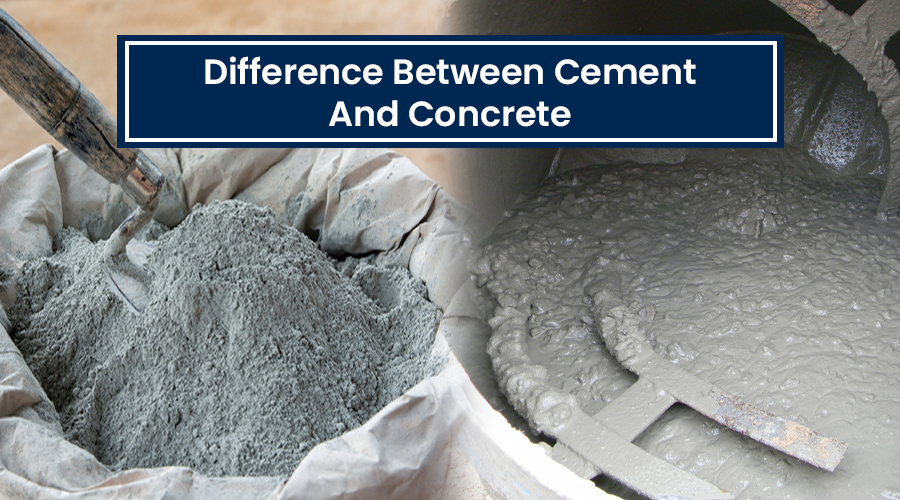Introduction
Cement and concrete are two materials that are commonly used in construction projects, but they are often mistaken for each other. While both are important building materials, they have different properties and uses. In this article, we will explore the differences between cement and concrete, their composition, and their applications.
What is Cement?
Cement is a finely ground powder that acts as a binding material to hold other materials together, such as sand and aggregates, to make concrete. It is made by heating a mixture of lime, silica, magnesia, calcium sulfate, sulfur trioxide, iron oxide, alumina, and alkaline in a kiln at high temperatures. The resulting material is then ground into a fine powder. Portland cement is the most common type of cement used in construction. Portland cement has five main constituents: calcium sulfate, tricalcium silicate, aluminum oxide, iron oxide, and gypsum. The ratios and composition of these constituents vary depending on the type of Portland cement, but they all provide the binding properties that hold the sand and aggregate together in the concrete.
Cement can also be used in other applications, such as in grout and mortar, which are used to fill gaps and bind materials together. Mortar is typically a mixture of cement, sand, and water and is used to hold bricks or other masonry units together. Grout is a similar mixture, but it is used to fill gaps between tiles or other materials.
Advantages of Cement:
Strength: Cement is a very strong binding material that can withstand high pressure and tension.
Durability: Cement is highly durable and can last for many years without degradation.
Versatility: Cement can be used in a wide variety of applications, from building foundations to bridges.
Resistance to Fire: Cement is highly resistant to fire, making it a popular choice for fireproofing applications.
Disadvantages of Cement:
Carbon Emissions: The production of cement is a major source of greenhouse gas emissions, accounting for around 8% of global emissions.
High Cost: Cement is relatively expensive compared to other construction materials.
Time-Consuming: The process of making cement is time-consuming, and it can take several days to produce a batch of cement.
What is concrete?
Concrete is a composite material made up of cement, water, sand, and aggregates (such as crushed stone or gravel). The aggregates provide bulk to the concrete, while the cement provides the binding properties. Water is added to the mixture to make it workable, and the resulting mixture is poured into forms or molds to create the desired shape.
There are many different types of concrete, depending on the intended use and the specific properties required. For example, high-strength concrete is used in bridges and other infrastructure projects that require a strong, durable material. Lightweight concrete is used in applications where weight is a concern, such as in roofing materials or precast concrete panels.
Advantages of Concrete:
Versatility: Concrete can be molded into any shape, making it ideal for architectural features, decorative elements, and more.
Durability: Concrete is highly durable and can last for many years without degradation.
Low Maintenance: Concrete requires very little maintenance over its lifespan.
Fire Resistance: Concrete is highly resistant to fire, making it a popular choice for fireproofing applications.
Disadvantages of Concrete:
Heavy: Concrete is a heavy material, which can make it difficult to transport and install.
Brittle: While concrete is strong, it is also brittle and can crack under certain conditions.
Carbon Emissions: The production of concrete also has a significant carbon footprint due to the production of cement.
Long Curing Time: Concrete can take several days to cure, which can slow down the construction process.
Applications of Cement and Concrete
Cement is used primarily as a binding material in concrete, but it is also used in other applications, such as grout and mortar. Concrete is used in a wide range of applications, from building foundations and walls to driveways and sidewalks. It is also used in the construction of bridges, dams, and other infrastructure projects. Concrete is a versatile material that can be molded into any shape, making it ideal for architectural features, decorative elements, and more. It can also be colored or stained to match any design aesthetic, making it a popular choice for both residential and commercial construction projects. High-quality cement can be ordered online from Builders9 for your future construction requirements.
Sustainability of Cement and Concrete
Cement and concrete are important building materials, but they are also responsible for a significant amount of carbon emissions. The production of cement is a major source of greenhouse gas emissions, accounting for around 8% of global emissions.
However, there are efforts being made to reduce the carbon footprint of cement and concrete. One way is by using alternative materials, such as green cement, light-emitting cement, or industrial byproducts, to replace some of the cement used in concrete.
Conclusion
Cement and concrete are two important building materials that are often used interchangeably, but they have different properties and uses with their own advantages and disadvantages. Cement is a binding material that is used to make concrete, while concrete is a composite material that is used in a wide range of applications. Understanding the differences between these materials is important for anyone involved in construction or home improvement projects.
While they are crucial to the construction industry, their carbon footprint is a growing concern. Efforts are being made to reduce the carbon emissions associated with the production of cement and concrete, including the use of alternative materials and improving production processes. By understanding the properties and uses of cement and concrete, we can make informed decisions about their use in construction projects.

